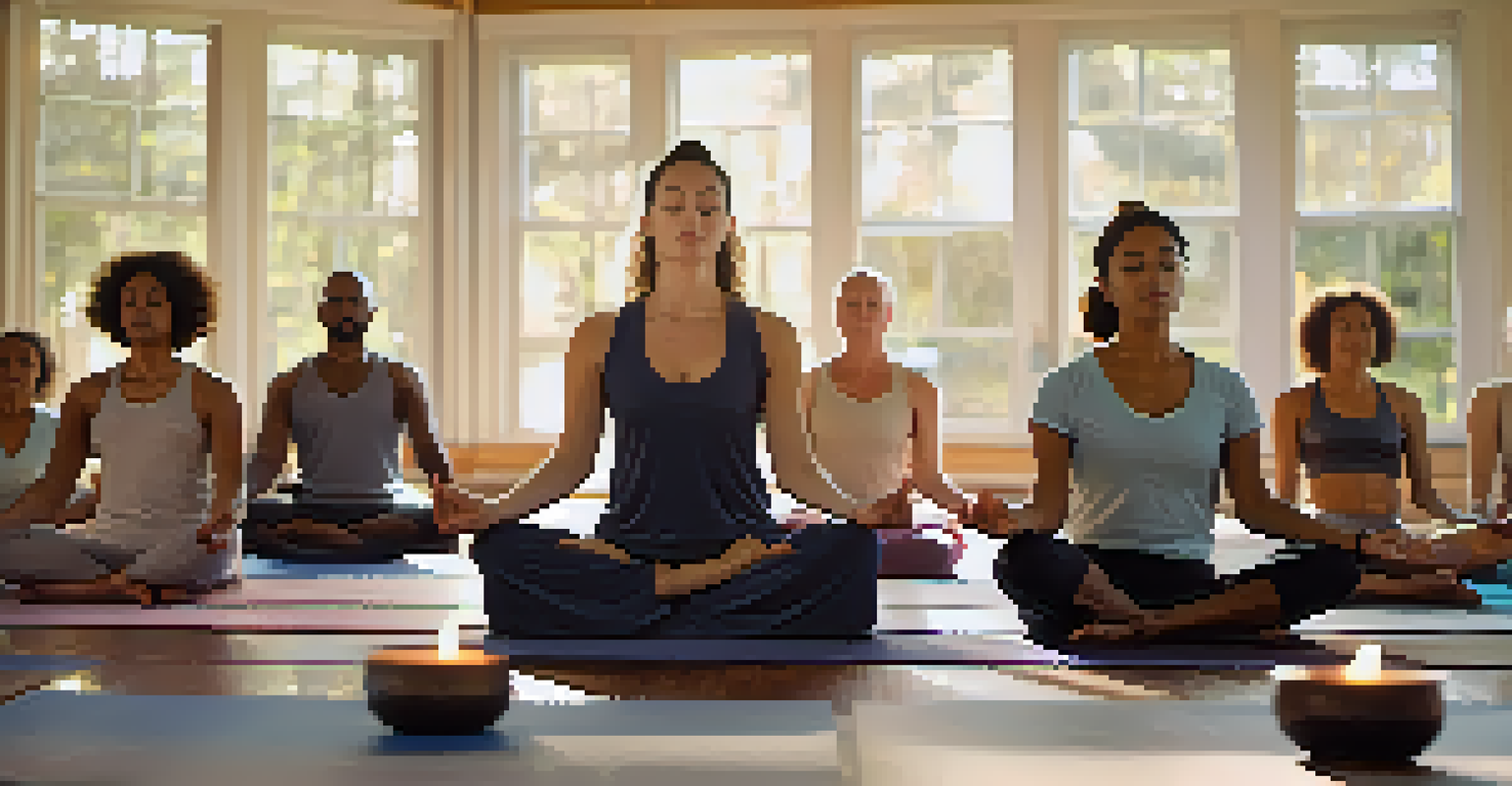Mindfulness and Community: The Power of Group Yoga

The Essence of Mindfulness in Yoga Practice
Mindfulness is about being fully present in the moment, which is a core principle of yoga. When we practice yoga, we focus on our breath, movements, and sensations, allowing us to connect deeply with ourselves. This awareness doesn’t just enhance our physical practice; it helps us cultivate a sense of peace and clarity in our minds. Think of mindfulness as a way to hit the 'pause' button on life, creating space for introspection and relaxation.
The mind is everything. What you think you become.
In a group setting, mindfulness takes on a new dimension. You’re not just observing your own breath and body, but also those of others around you. This shared experience can amplify the feeling of connection, making you more aware of the collective energy in the room. It’s like tuning into a symphony where each individual instrument contributes to the harmony of the whole, creating a richer experience than practicing alone.
Practicing mindfulness in a group can also help us cultivate empathy and gratitude. As we observe our fellow yogis navigating their own journeys, we recognize that we all share struggles and triumphs. This realization fosters a sense of belonging, reminding us that we are not alone in our experiences, but part of a larger community.
Building Community Through Shared Experiences
Group yoga classes provide a unique opportunity to connect with others who share similar interests. Whether you’re a beginner or an experienced yogi, everyone is there for the same reason: to deepen their practice and find some peace. This common goal creates an instant bond, breaking down barriers and making it easier to connect. It’s like being part of a team, where everyone supports each other’s growth.

As friendships develop within the yoga community, they often extend beyond the mat. Many practitioners find themselves forming connections that lead to social gatherings, workshops, or even retreats. These shared experiences cultivate a sense of belonging and support, enhancing the overall yoga experience. Imagine it as a garden where each friendship is a flower, blooming and contributing to the vibrant community.
Mindfulness Enhances Yoga Practice
Being present during yoga cultivates peace and connection, enriching both personal and collective experiences.
Moreover, the encouragement from fellow practitioners can motivate you to push your limits. When you see someone else mastering a challenging pose or maintaining focus during meditation, it inspires you to do the same. This collective energy can be incredibly uplifting, allowing individuals to grow in ways they might not have thought possible.
The Role of Instructors in Fostering Connection
Instructors play a vital role in creating a welcoming and inclusive environment during group yoga sessions. They set the tone for the class, encouraging participants to support one another and to cultivate mindfulness together. A good instructor can make everyone feel seen and heard, fostering a sense of community right from the start. It’s as if they are the conductor of an orchestra, guiding each participant to contribute their unique sound to the overall harmony.
Yoga is the journey of the self, through the self, to the self.
Well-structured classes often incorporate group activities, such as partner poses or group meditations. These activities not only enhance the physical practice but also encourage interaction among participants. When you share a laugh while attempting a partner pose, for instance, it breaks down the walls of self-consciousness and invites connection. Think of it as a dance where everyone is learning the steps together, making the experience more enjoyable and memorable.
Furthermore, skilled instructors often share their own stories and experiences, making them relatable and approachable. This authenticity fosters trust and openness, allowing participants to feel safe in sharing their own journeys. In this way, yoga classes can transform into a space where personal growth and community building go hand in hand.
Yoga as a Tool for Emotional Support
Yoga is not just about physical postures; it’s also a powerful tool for emotional healing. In a group class, individuals often feel safe expressing their emotions, whether that’s joy, sadness, or frustration. Sharing these feelings in a supportive environment can be incredibly cathartic, acting as a release valve for pent-up stress and anxiety. Imagine it like a collective sigh of relief, where everyone breathes out their worries together.
The shared experience of practicing yoga can help normalize struggles, making it easier for individuals to open up about their challenges. When someone shares their journey, it can resonate with others, creating a sense of camaraderie and understanding. This emotional connection is crucial, as it fosters a supportive network that extends beyond the yoga studio. It’s like having a safety net of friends who are there for you through thick and thin.
Community Supports Emotional Growth
Shared yoga experiences foster bonds that enhance emotional healing and create a supportive network.
Moreover, group yoga sessions can encourage accountability among participants. When you know others are counting on you to show up, it can be a motivating factor to prioritize your practice. This commitment not only strengthens individual resolve but also reinforces the bonds within the community, making it a nurturing space for emotional growth.
Mindfulness and Community: A Two-Way Street
The relationship between mindfulness and community is symbiotic; one enhances the other. When you engage in mindfulness, you become more aware of your surroundings and the people in your life. This awareness allows you to appreciate the community you’re part of, deepening your connections and enriching your life experiences. It’s like putting on a pair of glasses that lets you see the beauty in every moment and every interaction.
Conversely, being part of a supportive community encourages you to practice mindfulness more consistently. The encouragement and positive energy from others can help you stay focused on your practice, making it easier to incorporate mindfulness into your daily routine. Think of it as a team effort, where everyone’s dedication lifts each other up, creating a more vibrant and engaged community.
Ultimately, this two-way relationship cultivates an environment where both mindfulness and community can thrive. It’s a reminder that we are all interconnected, and our individual practices contribute to the collective experience. By nurturing both aspects, we create a space where everyone can flourish, both on and off the mat.
The Impact of Group Yoga on Mental Health
Group yoga has been shown to have numerous mental health benefits, including reduced anxiety and depression. The combination of physical movement, breathwork, and communal support creates a powerful antidote to stress. When you practice yoga in a group, the shared energy often amplifies these benefits, leaving participants feeling lighter and more at ease. It’s like a warm hug for your mind, wrapping you in comfort and reassurance.
Moreover, the routine of attending regular classes can provide structure and stability, which is particularly helpful for those experiencing mental health challenges. The consistent practice fosters a sense of accountability to oneself and the community, encouraging individuals to prioritize their well-being. Think of it as planting seeds of self-care that, with time and nurturing, grow into a flourishing garden of mental resilience.
Inclusivity Strengthens Yoga Communities
Creating inclusive spaces allows diverse practitioners to express themselves freely, enriching the yoga community.
Additionally, the social aspect of group yoga can combat feelings of isolation. Building relationships with others who understand your journey can be incredibly validating. This sense of belonging not only boosts self-esteem but also creates a support network that individuals can lean on during tough times.
Creating Inclusive Spaces in Yoga Communities
Inclusivity is essential to building a thriving yoga community. It’s important that everyone feels welcome, regardless of their background, experience level, or physical ability. Yoga should be a space where individuals can express themselves freely without fear of judgment. Think of it as a tapestry, where each unique thread contributes to a beautiful, diverse picture.
Many yoga studios are making conscious efforts to create inclusive environments by offering classes tailored to different needs and abilities. This might include gentle yoga for beginners, chair yoga for those with mobility concerns, or specific classes for LGBTQ+ individuals. By recognizing and respecting the diverse needs of practitioners, the community can flourish and feel more connected.

Furthermore, fostering inclusivity also means acknowledging and addressing the barriers that may prevent people from participating. This could involve offering scholarships for classes, providing accessible facilities, or actively promoting diversity within the community. Ultimately, creating an inclusive space not only enriches the community but also deepens the practice for everyone involved.